

On the 24th of January 1986, the Voyager 2 spacecraft encountered the planet Uranus and its system of moons. At a distance of nearly 3 billion kilometers from Earth, Voyager sent back intriguing pictures of the atmosphere of the planet, measured its magnetic field, examined its system of rings, and photographed the surfaces of its major moons. The data obtained from this brief encounter provide the basis for our understanding of the Uranian system. Because of the expense and time involved in making and launching new spacecraft, it is unlikely that we will learn significantly more about the satellites of Uranus in our lifetimes.
The discoveries of Voyager show that the Uranus system is one of the strangest collections of planet, moons, and rings in the solar system. The giant blue-green planet (Figure 11.1) is tipped and lies on its side as it goes around the Sun, possibly shoved into that position eons ago by collision with a planet-sized body. To compound its oddness, the magnetic axis of Uranus does not pass through the center of the planet. Like Saturn and Jupiter, Uranus has rings, but they are thin, tenuous, and coal black, and fewer than half have circular orbits. Also, like Jupiter and Saturn, Uranus has a substantial system of icy moons. Five major satellites are visible with telescopes on Earth; ten smaller satellites were discovered by Voyager 2. The spectacular pictures sent back by Voyager show that several major satellites, most notably Ariel and Miranda, were geologically active early in their histories.
1. Uranus is a large gas- and ice-rich outer planet, with a diameter less than half that of Saturn.
2. Uranus is composed mostly of hydrogen and helium, but it has a larger core of ice (including water, methane and ammonia) and rock than either Saturn or Jupiter.
3. Uranus is unique in that its spin axis is tipped almost 90 degrees from the normal solar system orientation. It seems that Uranus was tipped on its side when it was struck by a large body during its accretion. Moreover, its magnetic field is not centered on the spin axis; perhaps it is in the middle of a magnetic polarity shift.
4. A system of narrow rings encircles Uranus. The boulder sized particles are among the darkest objects yet found in the solar system.
5. Uranus is the center of a system of at least 27 satellites that are small icy bodies. Five lie between 450 and 1600 km in diameter and are large enough to be nearly spherical. The densities of these larger satellites range from 1.1 to 1.7 g/cm3.
5. The moons are heavily cratered but the two larger moons (Titania and Ariel) were modified by icy volcanism and limited tectonism. Large grabens cut the cratered terrain indicating global expansion occurred late in their histories, perhaps because of the expansion of freezing ice.
Many facts about Uranus are strange and unexpected. In contrast to all other planets in the solar system, Uranus spins on its side; that is, its axis of rotation lies nearly in the plane of its orbit (Figure 11.2). Thus, it rolls like a ball as it moves on its orbital path around the Sun, whereas other planets spin like tops. As Uranus revolves around the Sun, the north pole (over its spin axis) points directly toward the Sun at one time during its year and the south pole at another. It is speculatively suggested that, during the final stages of accretion, a large, icy planetesimal the size of the Earth collided with a growing Uranus. An off-center impact could have knocked Uranus on its side, never to recover. Models for the development of the solar system cannot produce such an orientation without invoking a collision with another object.
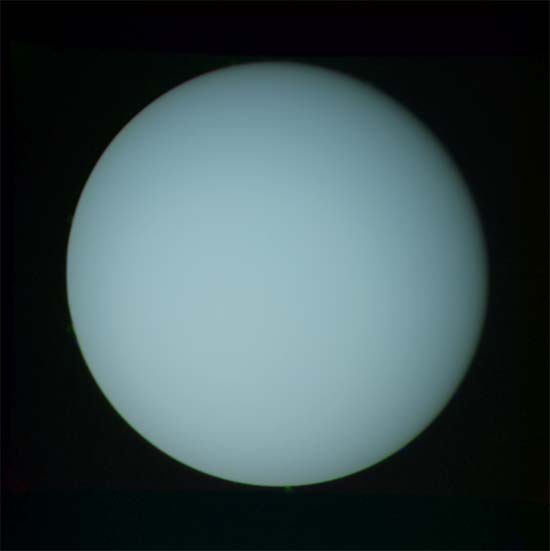
The Uranian realm is a dark kingdom, so remote from the Sun that it takes 84 Earth years to complete one revolution. Uranus is twice as far from the Sun as Saturn. Daylight on the moons of Uranus is roughly equivalent to a total solar eclipse on Earth. Uranus is also an extremely cold world. Since its time of origin, more than 4.5 billion years ago, temperatures in the Uranian system have never been higher than about 80 K. If the Earth were in the orbit of Uranus, our oceans would be frozen solid and our atmosphere of nitrogen would liquify. Uranus is so far from the Sun that it was not discovered until after the invention of the telescope. William Herschel, a British astronomer, discovered Uranus in 1781.
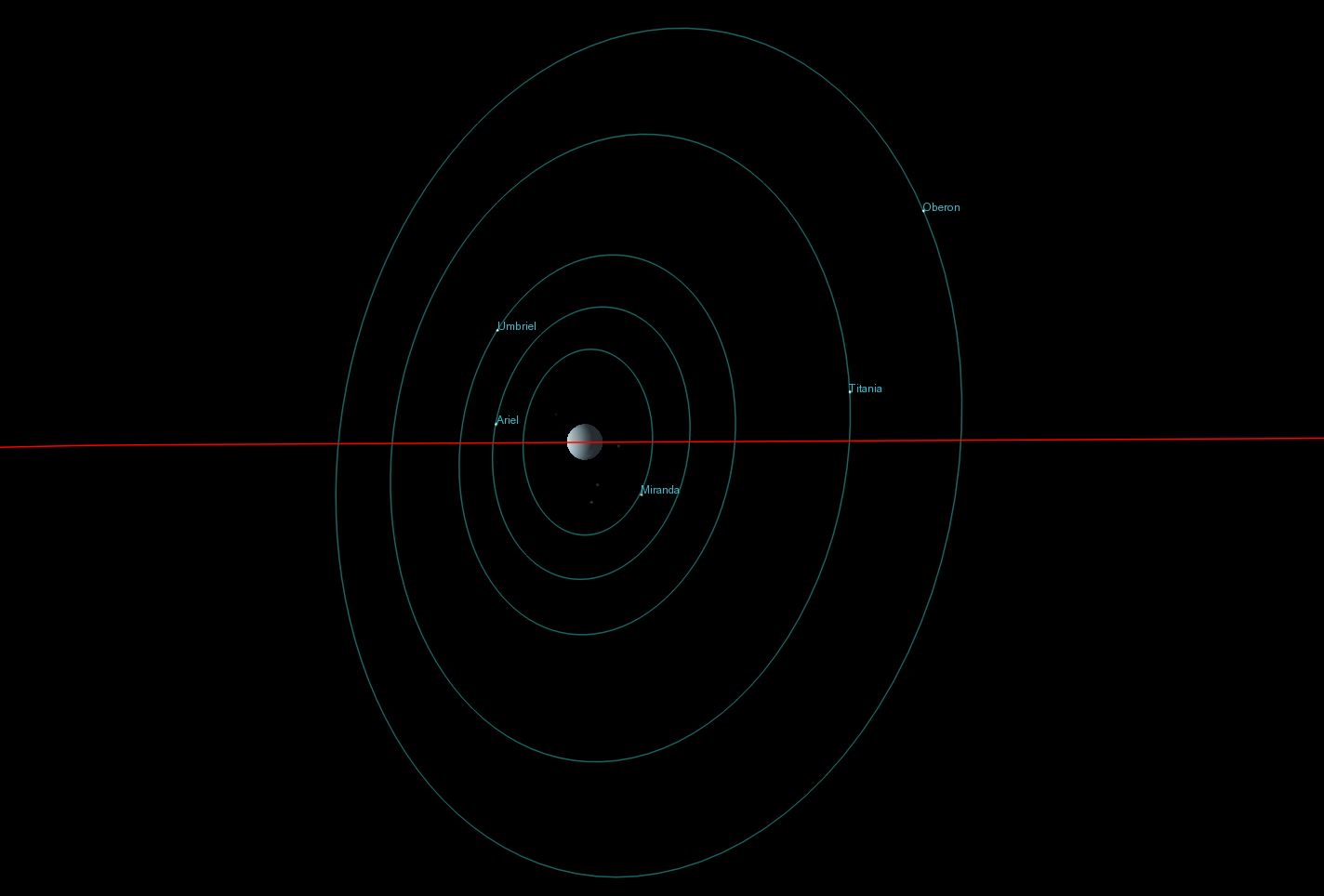
Uranus has at least 27 moons. The regular satellites of Uranus are compared in Table 11.2; five of them are greater than 450 km in diameter. Their relatively low densities and small diameters suggest that they are icy bodies that have much in common with the moons of Saturn.
Because of its low density and hydrogen-rich composition, Uranus is often grouped with the gas giants Jupiter and Saturn. In fact, the density of Uranus is 1.28 g/cm3 (liquid water has a density of 1), significantly higher than either Jupiter or Saturn. Therefore, in contrast to gas- and liquid-dominated Jupiter and Saturn, Uranus must be richer in dense solids, like silicates or ice, than either of the larger planets. Apparently, Uranus is composed mostly of ices of water, ammonia, and methane, thought to be the most abundant ices in the solar system. Moreover, Uranus is substantially smaller than the larger planets, with only about 5 percent of the mass of Jupiter. The growth of Uranus may have been limited by the supply of nebular gas. Dissipation of the nebula occurred while Uranus was growing, stealing away some mass that could have become part of Uranus. Gas may have been lost during the T Tauri stage of the Sun's evolution. Moreover, Uranus is much farther away from the center of the Solar System and the amount of nebular gas and dust must have been much lower here than closer to the Sun. Thus, the outer planets were not able to accrete as much mass as those closer to the Sun but outside of the snow line. Consequently, the outer planets become smaller with distance from the Sun. We have to remember, though, that Uranus and Neptune may have once been closer to the Sun than they are now and were pushed farther out into the Solar System during the chaotic orbital changes that may have occurred about 4 billion years ago.
Various measurements made from Earth and Voyager 2 provide enough information so that a model of the interior of Uranus can be constructed (Figure 11.3). Uranus is believed to consist of three major components. A small, dense core of silicate rock and metal may lie at its center. This core is about 70% the diameter of Earth. It is probably surrounded by a thick mantle of ice (probably in semi-fluid state). The principal ices are probably water, methane, and ammonia. The outermost shell is gaseous, consisting mostly of hydrogen, helium, and traces of other gases (the atmosphere). The data acquired by Voyager 2 about the rotation rate and tidal bulge of Uranus suggest that the core may consist of a mixture of dense silicates and ices. Most of the mass of Uranus is in the icy mantle (about 90%), less than 4% of it is rock, and the remaining few percent is hydrogen, helium, and other gasses There is a possibility that the ice and rock are separated into discrete layers, but some rock will dissolve in water at the high temperatures that must prevail inside Uranus.
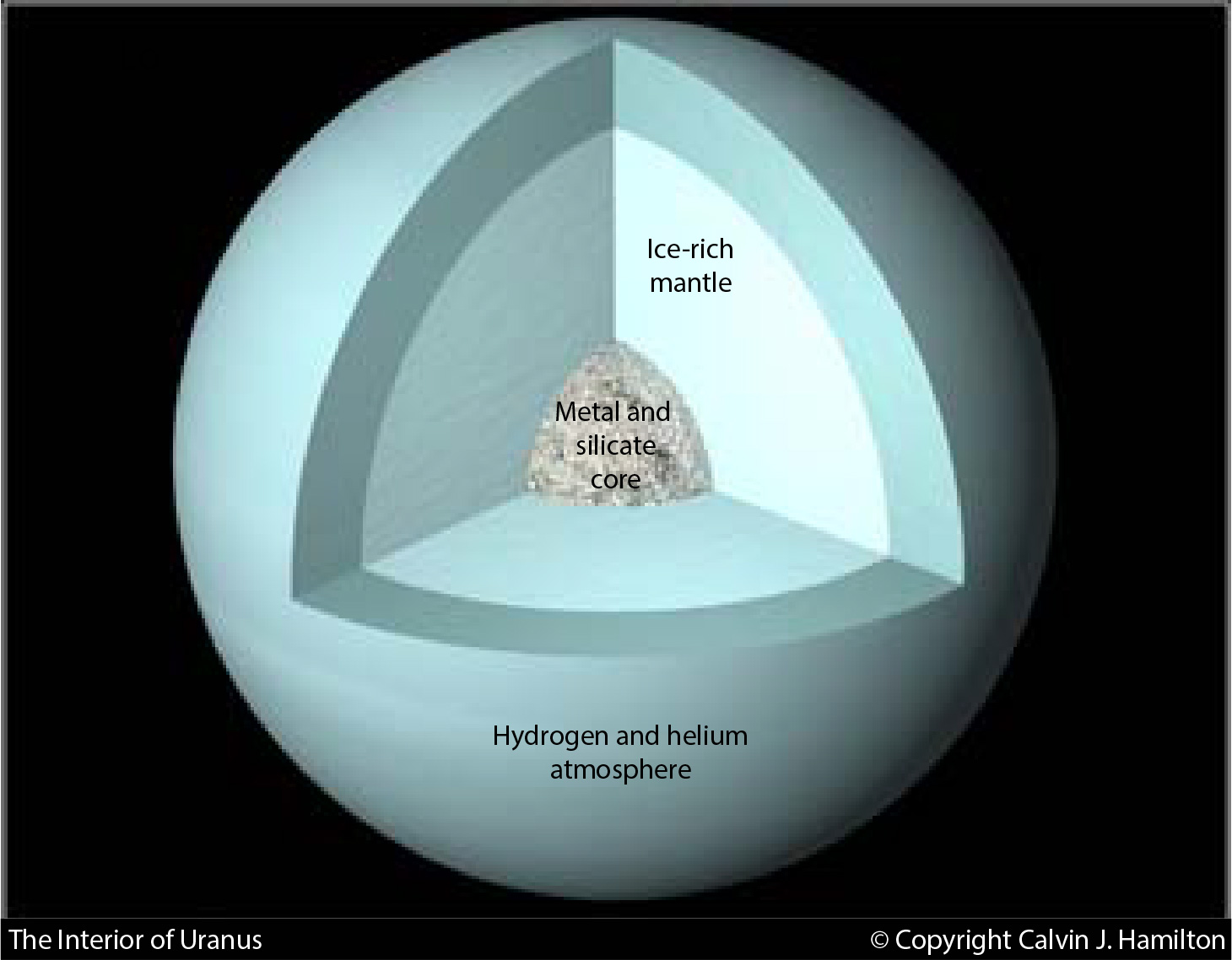
Uranus has a small magnetic field, about 10 times smaller than Earth's. However, it is not as simple as had been expected. To the complete astonishment of scientists, the magnetic axis is tilted approximately 60 degrees with respect to its axis of rotation. It is not known why. Perhaps Uranus is undergoing a magnetic reversal, in which the north and south poles switch places. Such reversals have occurred many times on Earth. The axis of the magnetic field is also offset from the planet's center. The magnetic field of Uranus, like those of other planets, appears to have developed in response to the convective movement of electrically conductive fluid (probably water) in the planet's icy layers. Convection may be driven by heat produced by radioactive decay of potassium, uranium, and thorium. These elements probably occur in the rocky part of the interior of Uranus.
Nonetheless, heat flowing from Uranus is also very low. The planet radiates only about 14% of the amount of heat that it receives from the Sun. This is about the amount of heat we expect to be generated by the decay of radioactive elements in its rock and ice core. There is no evidence that H and He are separating within the interior of Uranus. It appears that Uranus lacks the distinctive metallic hydrogen zone necessary for this type of differentiation to occur. Helium remains dissolved in molecular hydrogen and does not rain out. Uranus is too small and its internal pressure too low for the transition from molecular to metallic hydrogen to be reached, so it retains the same proportions of hydrogen (about 74%) and helium (about 26%) in its atmosphere as does the Sun. Methane and ammonia have also been detected, but many other species are probably present in trace amounts.
In contrast to Jupiter, the atmosphere of Uranus does not dazzle the observer with details of its clouds, storms, and exotic spots. Visually, the most striking thing about Uranus may be just how bland it seems (see Figure 11.1). The planet is an almost featureless blue-green ball in which tumultuous clouds of ammonia or water ice, believed to occur at lower altitudes, are obscured. The color results from methane in the planet's atmosphere. Even with computer enhancement of the imagery sent back by Voyager 2, only a few deeply embedded methane clouds and faint smoggy haze were revealed. The visible clouds of Uranus are composed of methane. In sharp contrast, Jupiter's manifold atmospheric features are defined by clouds of ammonia ice particles. Voyager scientists discovered faint latitudinal bands in the atmosphere of Uranus, centered on the pole of rotation (Figure 11.4). The few small clouds reveal latitudinal (rather than poleward) circulation in the atmosphere. Uranus shares this characteristic with Jupiter, Saturn, Venus and, to a lesser extent, Earth and Mars, although solar radiation at Uranus is most intense at its poles rather than at its equator. Apparently, the rotation of the planet is very important in determining atmospheric circulation patterns. Wind velocities are estimated to range up to 700 km/hour; they cause the upper cloudy part of the atmosphere to rotate more quickly than the interior.
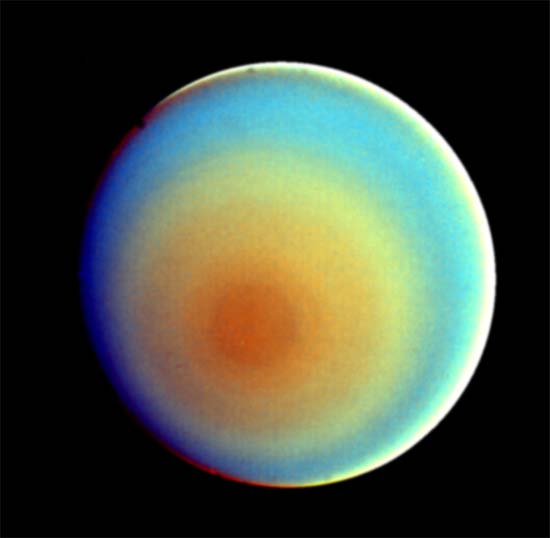
Like Jupiter and Saturn, Uranus has a system of rings (Figure 11.5), but the particles in the rings are dark gray and were not detected by telescopes on Earth until 1977. They are some of the darkest objects ever studied in our solar system. A multitude of narrow rings have been identified, together with many dust bands. Most lie within one planetary radius of the cloud tops, but in 2003 NASA's Hubble Space Telescope found a more distant pair of rings. The newly discovered dusty rings are extremely faint. The outermost ring may be replenished by dust blasted off a small satellite embedded in the ring. The new outermost ring has twice the radius of the previously known rings.
All of the rings are narrow, ranging from nearly 60 km to less than 2 km in width. For the most part, the rings of Uranus are made up of fairly large particles; in fact, boulder- to house-sized fragments seem to dominate. The Epsilon ring (the outermost ring shown in Figure 11.5) is made up almost entirely of black boulders; many are more than 10 m in diameter. Voyager 2 also discovered hundreds of dust bands within the ring system. If all of the ring particles were accumulated into one moon, it would have a diameter of only 150 km. What are the dark particles in the rings? Some think they consist of carbon-rich residues, made as methane ice in ring particles blackened and decomposed during exposure to solar radiation. Others suspect ring particles are made of exotic black rock, rich in organic compounds and ice. The rings lie in the equatorial plane of Uranus, tipped as it is. This suggests that the rings formed after Uranus fell on its side. If the rings existed before this planetary trauma, it is unlikely that they would reorient their orbits following the large impact.
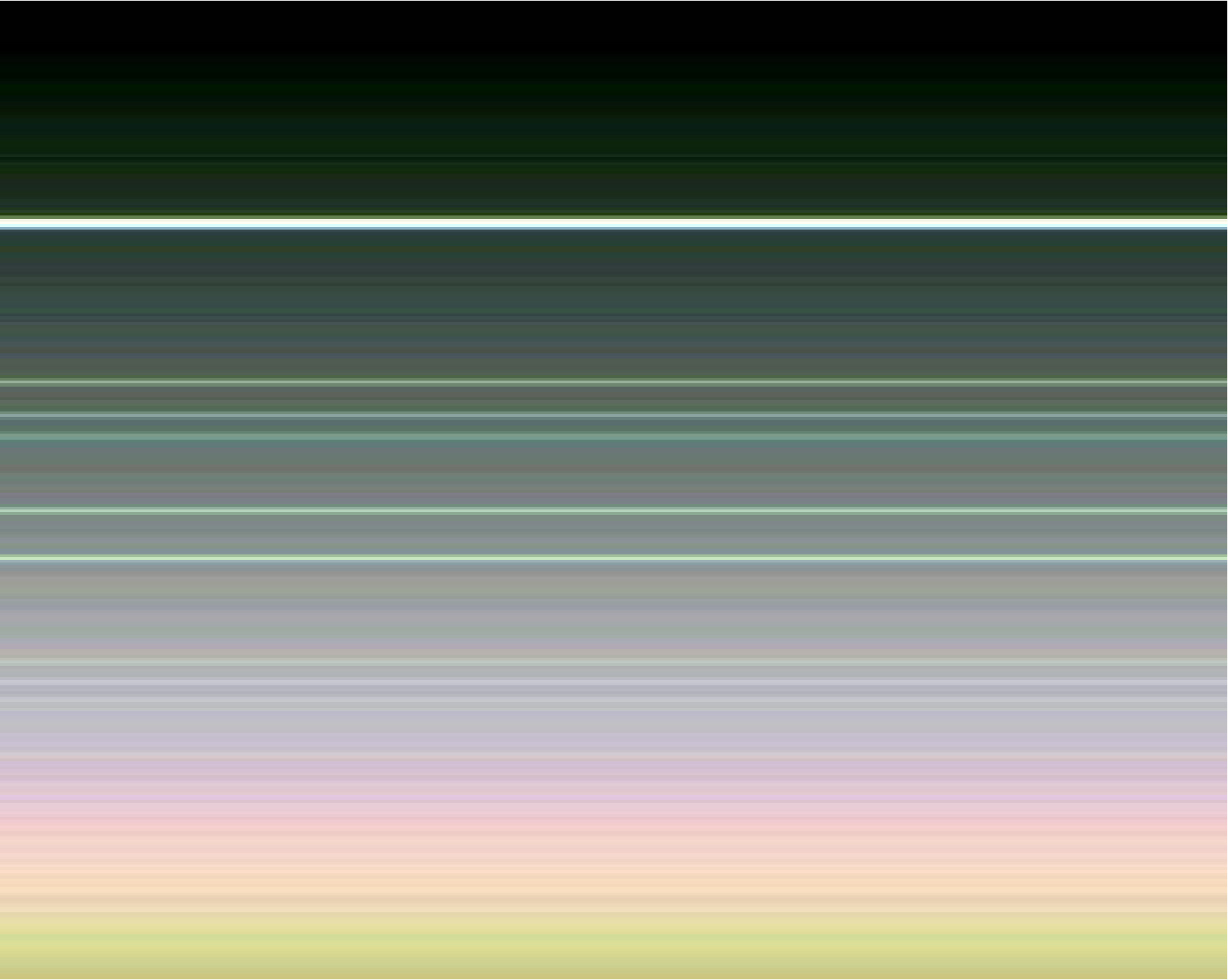
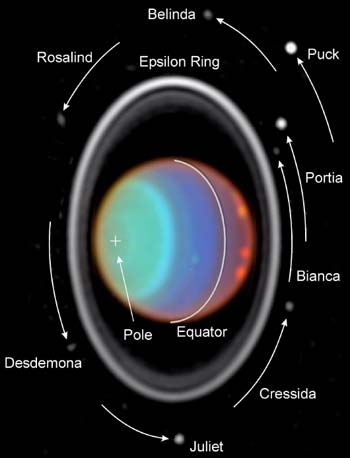
Compared to Saturn's bright, complex rings, which are tens of thousands of kilometers across, the Uranian rings are but thin strands. The delicate rings are probably defined by shepherd satellites, although only two were found---one inside and one outside the most massive outer ring.
From studies of the narrow rings of Uranus, some have suggested that planetary rings may be short-lived phenomena that come and go during a planet's lifetime. For example, the dust rings discovered by Voyager 2 may have lifetimes of less than 1000 years, because the extended atmosphere drags on the particles, slowing them down, until they spiral into Uranus. Based on the orbital characteristics of the shepherd satellites, the rings may have lifetimes of less than 600 million years. Although this is much longer than the duration of dust belts, it is much shorter than the age of the solar system. They must, therefore, have a continuing source or they would have disappeared long ago. Uranian ring particles may be the flotsam produced by collisions of small satellites within the system or perhaps by collisions with cometary interlopers. Subsequently, the rings may in a sense erode themselves away as their large particles collide with each other, grinding down to dust that is swept away, ultimately showering down onto the planet below.
An important problem with the young ring hypothesis is that rings are present around all of the large outer planets. Would impacts have coincidentally produced rings about all of the planets in one brief moment of time? If rings are continually produced and eroded away, then a large amount of satellite material must have been consumed. Perhaps the rings are indeed long-lived relics of the disc of particles from which the satellites accreted. Other planetary scientists have hypothesized that the ring fragments condensed from the gas blown off Uranus by the giant collision that tilted the planet on its side.
Uranus has five major icy moons that were discovered using telescopes on Earth before the space age. In order outward from Uranus they are Miranda, Ariel, Umbriel, Titania, and Oberon. Like most other planetary satellites, all of these moons are in tidally locked orbits with the same face always pointing toward Uranus (Figure 11.2). Ten small satellites were identified by Voyager 2 and others have been discovered by the Hubble Space Telescope and from Earth-based telescopes.
All of the large satellites occupy orbits lying in the plane of Uranus' equator. Thus, their orbits share the unusual inclination of the planet itself. They must have formed from a circum-Uranus nebula after the planet was bowled over on its spin axis. Oberon, Titania, Ariel, and Umbriel are quite similar in size (1100 to 1600 km in diameter) and are approximately the size of the intermediate moons of Saturn (Tethys, Dione, and Rhea). Miranda is considerably smaller, with a diameter of only 500 km, and is approximately the same size as Saturn's moon Mimas. Atmospheres have not been detected around any of the Uranian satellites.
Water ice, but not methane or ammonia, has been identified at the surface of all five major moons. (Methane and ammonia could be expected to be important constituents in the interiors or on the surfaces of these moons because temperatures at this great distance from the Sun may have been low enough for these volatile compounds to have condensed in the ancient solar nebula from which the planets formed. Moreover, methane has been detected on a moon of Neptune and on Pluto.) The surfaces of all the moons are dark, or perhaps dirty mixtures of rock and ice, maybe because of impact processes.
Like the moons of Saturn, the interiors of the Uranian moons are probably mixtures of low density ice and denser silicate rock and iron. The Uranian moons are somewhat denser (1.3 to 1.6 g/cm3) than those of Saturn, perhaps suggesting that they consist of a larger proportion of rocky material, perhaps about 60% silicate rock and 40% ice. At first glance this may seem to be opposite the expected trend for the cold, outer reaches of the solar system. In the ancient solar nebula, we might have expected the proportion of low density methane ice (0.5 g/cm3) to increase as we moved farther and farther from the Sun. The relatively high densities of these satellites tell us that instead, much carbon resided in very volatile carbon monoxide, instead of in methane. Apparently, carbon monoxide was a gas at the distance Uranus lies from the Sun. Consequently, the ratio of rock to ice was higher in the condensates that formed in the outer solar system.
We discuss the satellites in the order of their occurrence outward from Uranus.
Thirteen moons are known to orbit closer to Uranus than Miranda (Figure 11.2 and Table 11.2). Two of these satellites, Cordelia and Ophelia, are ring shepherds, which gravitationally define the inner and outer edges of the outermost ring. The largest of the inner satellites, Puck, is about 160 km in diameter and Voyager 2 photographs show that it is darker than any of the large Uranian moons and slightly irregular in shape. Like other small objects in the solar system, Puck is also cratered. The other small inner satellites, including ones named Juliet and Cupid, have diameters between 18 and 135 km and were not photographed in enough detail to show surface features, but are all quite dark. This suggests that either icy materials at their surfaces darken by some sort of aging process involving methane ice or, as most investigators speculate, the dark material is an undifferentiated mixture of icy, silicate, and carbonaceous materials. If this latter explanation is correct, these small moons preserve some of the most chemically primitive material in the outer solar system.
Another set of satellites lie beyond the orbit of Oberon. Most of these small satellites have highly irregular orbits that are strongly inclined to Uranus equator. All but one also have retrograde orbits--that is they orbit in the direction opposite to Uranus spin. Both the high inclination and the retrograde motions suggest that these outermost moons formed elsewhere and were later captured by Uranus.
Voyager 2 flew within 29,000 km of the little moon, Miranda, and photographed remarkable detail of its surface features (Figure 11.6). Because of its small size, most scientists expected it to be a bland ball of water ice, little changed since its birth more than 4.5 billion years ago. What the pictures of Miranda revealed was one of the strangest planetary bodies in the solar system. Miranda is the smallest of the major Uranian moons (470 km in diameter) and occupies the innermost orbit. It has barely enough gravitational strength to pull itself into a sphere. In spite of its small size, its surface consists of complex and exotic terrains unlike anything seen on other satellites.
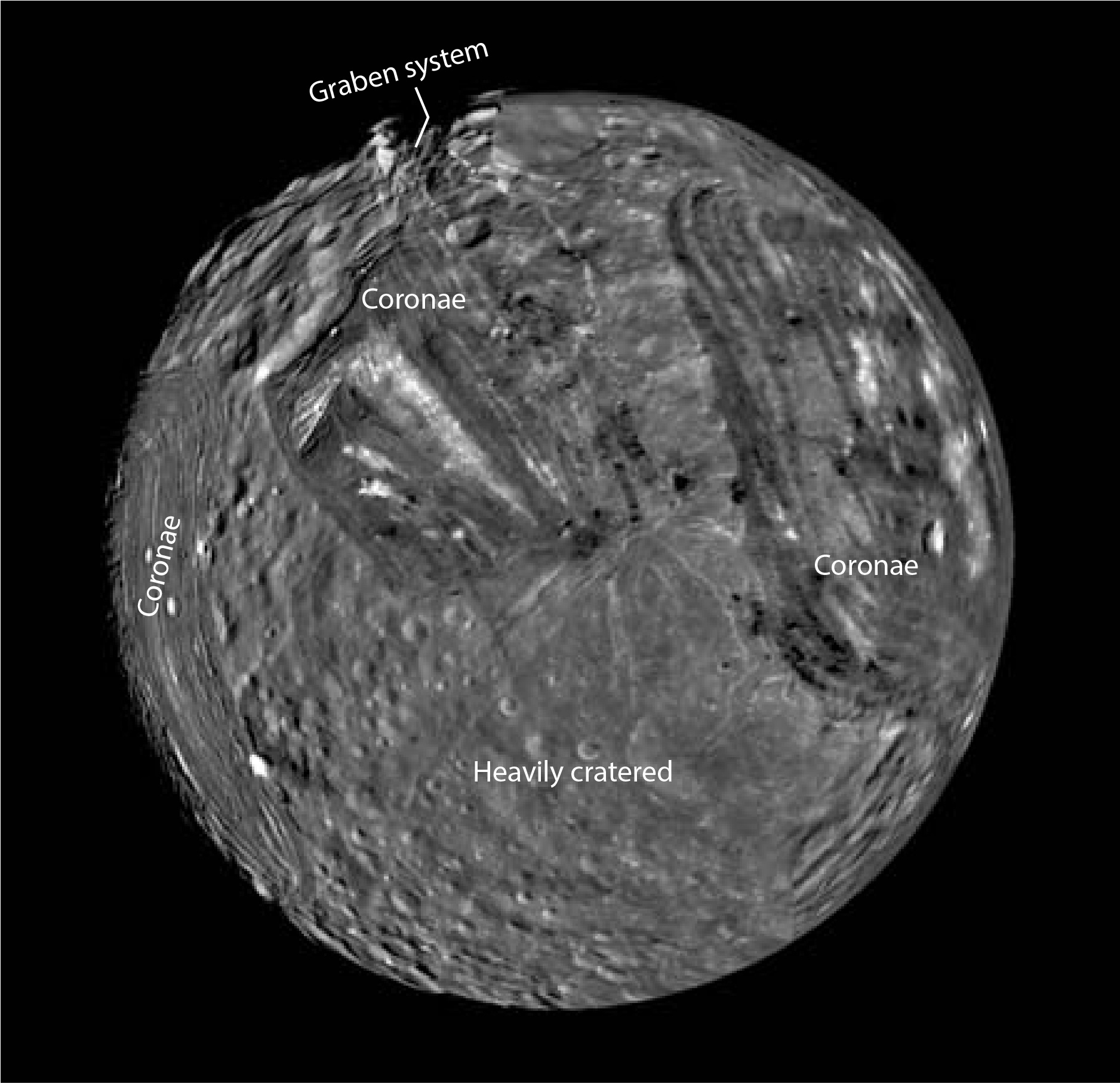
Two strikingly different terrain types have been delineated on Miranda (Figure 11.6). One is an old, heavily cratered surface that is similar to the lunar highlands and therefore probably more than 4 billion years old. The other terrain type is completely different and consists of three roughly circular or oval areas of complex structures marked by parallel sets of alternating light and dark bands, scarps, and ridges. These terrains have been called coronae because of their ovoidal shape and the rings of distinctive terrain that surround them. Judging from the numbers of craters on the ovoids, it appears that the coronae are substantially younger than the heavily cratered plains. The most prominent of these exotic areas is located near the north pole (center of Figure 11.6, Figure 11.7). Its outer boundary is sharp and angular, and the internal pattern of ridges and bands displays many sharp corners. Inside this crustal fragment is a strange, angular V-shaped structure marked by bands of light and dark material (Figure 11.7). The outstanding features in this area are that the outer boundary and the internal V have many sharp corners, and that some ridges and grooves are truncated by sharp boundaries.
Another corona, shown on the right side of Figure 11.6, consists of light and dark discontinuous bands that curve smoothly around a core marked by light blotches on a darker terrain. The third corona is located to the left on Figure 11.6. It consists of closely spaced ridges surrounding an inner core of complex intersecting ridges and troughs. Both the ridged and banded terrains have an outer belt approximately 100 km wide that resembles a racetrack and wraps around an inner core (Figure 11.6). This outer band is actually a trough 5 to 6 km deep. Faults that cut across the cores of the coronae truncate against the bounding beltway. The ridged and banded terrains somewhat resemble the grooved terrain on Ganymede. Faulting and extrusion of volcanic liquids or solid but plastic materials were undoubtedly involved in their formation. These three coronae developed in the crust of Miranda are unique. Nothing like them has been seen anywhere else in the solar system.
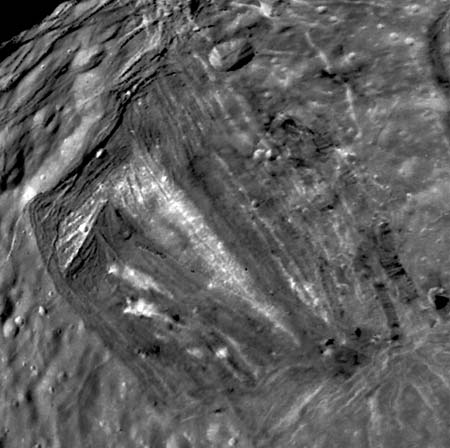
Miranda also has a series of enormous faults that can be traced across the globe. Some are older than the complex coronae; others are younger. The most spectacular is a huge fault scarp 7 to 10 km high (Figure 11.8). It forms a rift valley near the top of Figure 11.6 and extends southward along the margin of the trapezoid, where it disappears in the unilluminated hemisphere. This steep rift valley is deeper than Valles Marineris on Mars. Other grabens can be seen as well; all show that Miranda experienced global expansion at some point in its history.
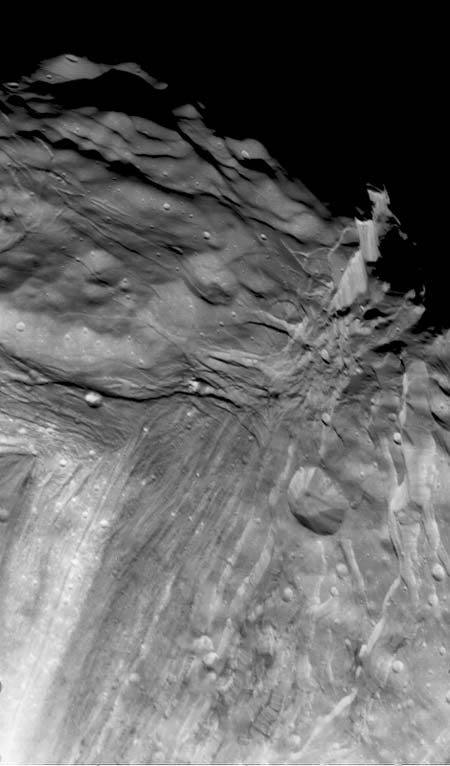
Why does Miranda have such strange and unusual terrains? How did such a surface develop on a tiny ball of ice? Several models have emerged to explain Miranda's coronae. One view holds that when Miranda accreted it was an uniform mixture of rock and ice. Because of internal heating, the small body began to differentiate. Masses of dense rock sank toward the center and plumes or sheets of lighter ice rose past the margins of the rock and eventually breached the surface as volcanic liquids to create the coronae. The complex ovals are surface disturbances left by the sinking rock masses. The distribution of the coronae on the surface suggests some sort of organized flow of material within Miranda's interior---perhaps from a poorly developed convection pattern. According to this theory, the process of planetary differentiation was slow to start and then aborted, never to be completed. If it had been completed, more ice would have risen to the surface and the coronae would have been smoothed over. The relatively young age of the coronae could be explained if Miranda was temporarily in a resonant orbit with a forced eccentricity. Such a orbit could cause tidal heating and start internal differentiation.
Beyond the orbit of tiny Miranda lie Ariel and Umbriel. These two satellites are roughly the same size (1160 and 1170 km in diameter), but they had strikingly different geological histories. Whereas Umbriel has the oldest and darkest surface of the major Uranian moons, Ariel has the youngest and brightest (Figure 11.9).
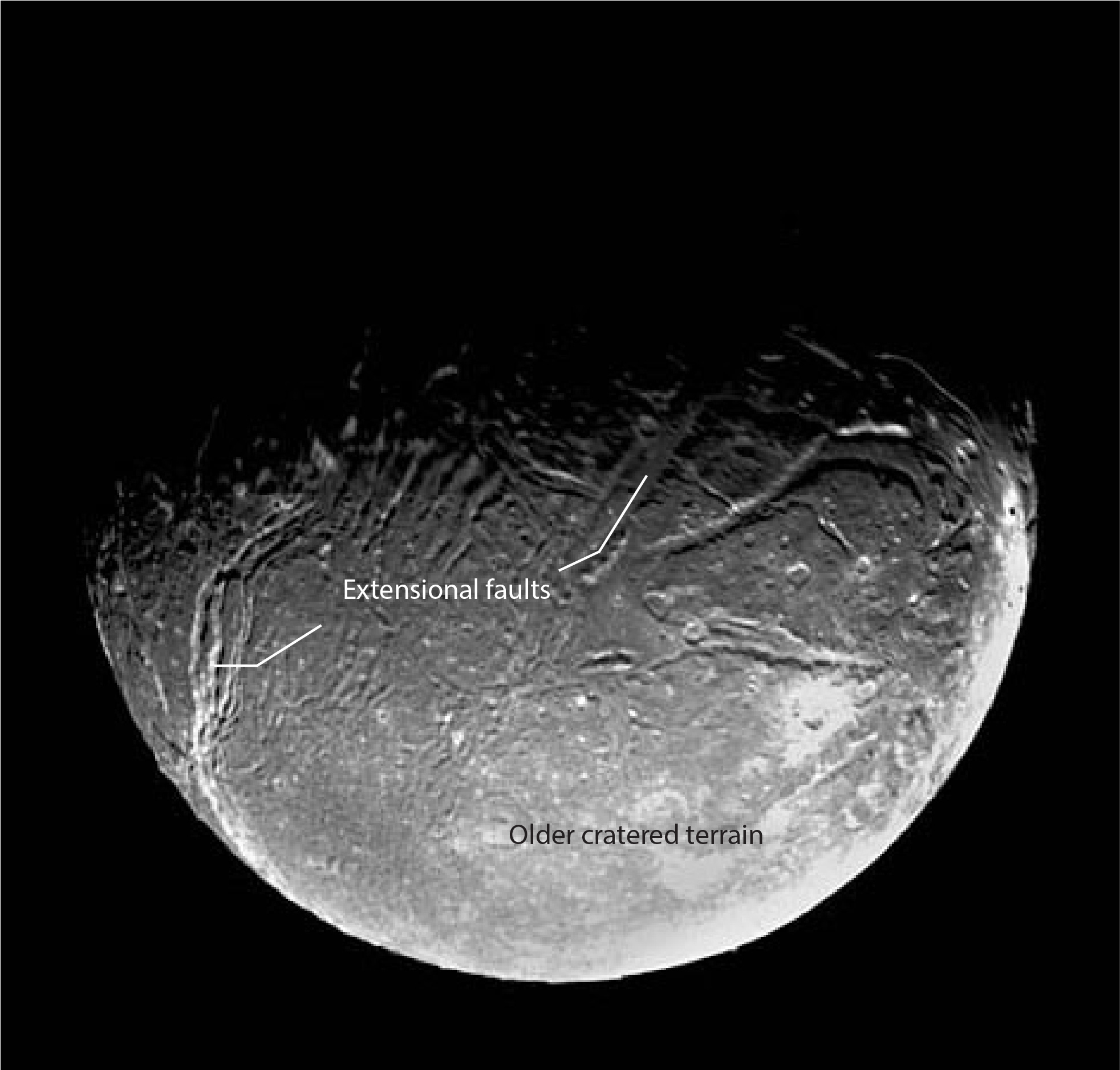
Same as for Saturn's moons, two types of cratered terrains have been identified in the Uranian system. One type is covered by closely spaced craters with diameters of 50 to over 100 km, and is similar to the lunar highlands. The impactors responsible for the formation of these terrains, and for the craters on the inner planets, were probably the remnants of planetary accretion and moved in orbits around the Sun. These bodies were probably swept up rapidly during and after accretion of the moons. The other type of cratered terrain has far fewer craters in the size range of 50 to 100 km, and instead has many small craters. Some scientists think these craters were produced by the myriads of small objects created by satellite collisions in orbits around the planet---here Uranus.
The oldest surface on Ariel is a widespread cratered terrain consisting mostly of impact craters less than 60 km in diameter (Figure 11.9). As judged by crater frequencies, Ariel has the youngest surface of the Uranian moons. An older set of larger craters, seen for example on Umbriel, must have been covered by volcanic extrusions of ice and slush, modified by tectonic disruption or by isostatic adjustments while the lithosphere was still warm. Some small, highly flattened craters are still visible on Ariel, showing that viscous flow of the icy lithosphere has occurred locally.
The most striking feature on Ariel is the global system of fractures and faults that form spectacular, deep rift valleys (Figure 11.10). In some places the rift valleys on Ariel are as deep as the Grand Canyon on Earth. Some of the older fault scarps are modified with young impact craters, whereas the younger scarps are remarkably fresh and free from superposed craters. These relationships show that the faulting occurred during the formation of the younger craters. The floors of most of the rift valleys are covered with smooth material, perhaps extrusions of slushy mixtures of water and ammonia ice that welled up through the fractures and spread out across the floors of the valleys like terrestrial glaciers. A sparsely cratered terrain occurs between the fracture system in the northern latitudes and was presumably formed by a sequence of flows that partly overlapped the older craters near the equatorial region. Occasionally, ghosts of underlying craters protrude from the plains. The youngest features on Ariel are bright-rimmed craters and their ejecta. Their abundance is roughly that expected for impacts during the last 3 or 4 billion years.
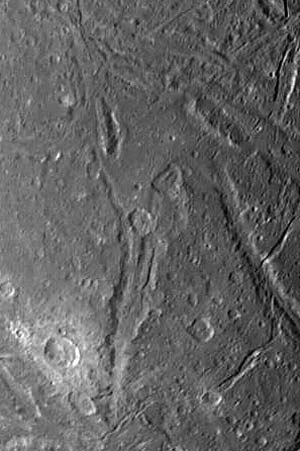
The geologic history of Ariel is complex---it is not a simple, undifferentiated sphere---and the major events are quite clear. After accretion, Ariel must have experienced the period of intense bombardment that scarred the surfaces of all other planetary bodies in the solar system and so once displayed a surface with relatively large impact craters. The craters on this surface, no longer apparent on Ariel, may have been obliterated by viscous relaxation together with watery volcanic extrusions of a low-melting-point liquid derived from Ariel's interior. Magma may be created by melting of an icy ammonia-water mixture in an undifferentiated mix of rock and ice. Thus, Ariel may be only partially or wholly differentiated into a core of dense silicates and an icy mantle like the Galilean satellites. A later period of bombardment by smaller objects created a new set of smaller impact craters that are still visible on the surface. As Ariel's surface layers, once heated by accretion, cooled and expanded around a still-warm interior, its lithosphere may have exapanded and ruptured, creating a network of extensional faults and grabens. This extensional tectonism may have been accompanied by further extrusion of fluids along the fracture zones and could have produced the smoother plains. The few bright-rayed craters seen on Ariel were formed by subsequent impact over the past several billion years.
But where did the heat come from to keep Ariel active and warm for such a long time? As we have seen before, these small, icy moons rapidly lose their small amount of accretionary heat and have little from radioactive means. Is tidal heating the answer, as on Io? At present, no orbital resonances exist in the Uranian system of moons. This is critical, because, to maintain significant tidal heating in a synchronously rotating satellite a resonance is necessary, since it forces the orbit to be eccentric (Chapter 9). It is possible that Ariel and Umbriel, the next moon out, had a 2:1 resonance in the past. However, once stable resonance is achieved, it is difficult to disrupt. Thus, no entirely satisfactory solution is in hand. What is certain is that Ariel has been significantly modified by thermal processes after its accretion and heavy bombardment.
Umbriel is a dull, gray world 1170 km in diameter, and is the darkest of the Uranian moons (Figure 11.11). The Voyager photographs of Umbriel are not as good as those of Miranda, but they show an ancient surface saturated with large, muted craters. This distribution of craters, especially those between 50 and 100 km in diameter, closely resembles that of the lunar highlands, as well as that of the most ancient, heavily cratered bodies in the solar system. Note how the crater population on similarly sized Ariel is strikingly different (Figures 11.9 and 11.11). There is a puzzling absence of the rayed craters visible on other Uranian satellites.

Little or no evidence of significant tectonic activity on Umbriel has been discovered. Thus, the surfaces of Umbriel, along with that of Oberon, appear to be the most ancient surfaces of the major satellites of Uranus, having remained relatively unaltered since the period of intense bombardment over 4 billion years ago. In this respect they are similar to Jupiter's Callisto.
Titania is the largest moon orbiting Uranus, but is less than half the size of Earth's Moon. It is similar to Oberon in general global properties, such as size, density, and color, but the histories of the two satellites are quite different. In fact, the surface of Titania (1610 km in diameter) is more like the much smaller Ariel (1160 km in diameter) than Oberon.
Titania is dominated by impact craters, and may at first glance look like Oberon. A comparison of Figures 11.12 and 11.13 shows that Titania has fewer craters than Oberon or Umbriel. Its surface must be younger. Moreover, most of the craters on Titania are small (less than 100 km across). This fact is important. Titania must have experienced the same period of intense bombardment as did Umbriel---indeed, as did all other planetary bodies in the solar system. Large, old craters were subsequently obliterated as the planet was resurfaced, perhaps by the extrusion of lava (slushy ice) or viscous relaxation of older, larger craters. The hypothetical new surface of low relief was subsequently modified by the impact of many smaller bodies forming terrains covered by smaller craters. Moreover, the crater density on Titania is not uniform. Several areas are distinctly smoother and less cratered than others, showing that the resurfacing processes on Titania extended over a significant period.
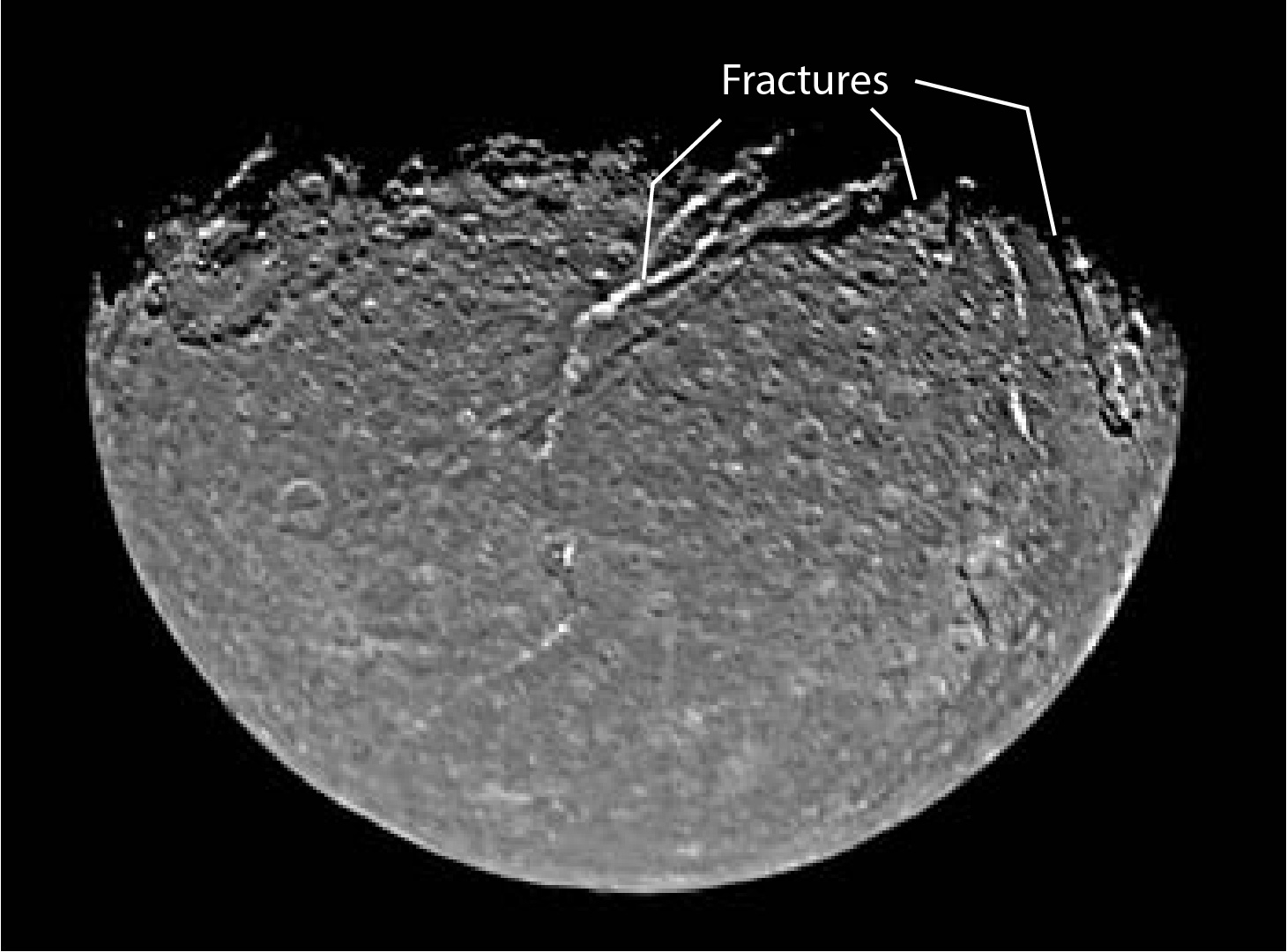
Like Ariel, Titania is crisscrossed by a near-global network of rift valleys and the extensional faults that bound them, suggesting late global expansion (Figure 11.12). The grabens are large structures with vertical relief on the fault scarps ranging from 2 to 5 kilometers. Careful study of Figure 11.12 will show that the faults cut the larger craters and are not modified by the smaller ones. The rifts are therefore among the youngest features on Titania.
Thus, the surface features and geologic activity on Titania are reminiscent of those of Ariel, except that the tectonic activity and resurfacing of Ariel were more intense, more extensive, and more prolonged. These similarities and differences are evident in Figures 11.9 and 11.12. The global network of fault valleys is more fully developed on Ariel, and the plains are noticeably less modified by craters.
With a diameter of 1550 km, Oberon is only slightly smaller than Titania. Significant differences between these otherwise similar moons are obvious in Figures 11.12 and 11.13. The gray surface of Oberon is nearly saturated with large craters that range up to 100 km in diameter. Note the similarities in crater populations on Oberon and Umbriel (Figures 11.11 and 11.13) and how the crater population on Titania is strikingly different (Figure 11.12). The density of these craters is more similar to that found on the lunar highlands, indicating that most of the surface was formed during intense bombardment. A high mountain is visible near the limb of Oberon. It may be a central peak of an otherwise invisible large impact structure several hundred kilometers in diameter. Bright rays are found around a few craters, but there is no global pattern of light and dark material. The floors of a few large craters are covered with dark material that could be lava composed of carbon-rich, dirty ice extruded after the period of intense bombardment, but there is no evidence of large, smooth plains. Several linear features that resemble faults are seen on Oberon, but there is little other evidence of major tectonic activity.
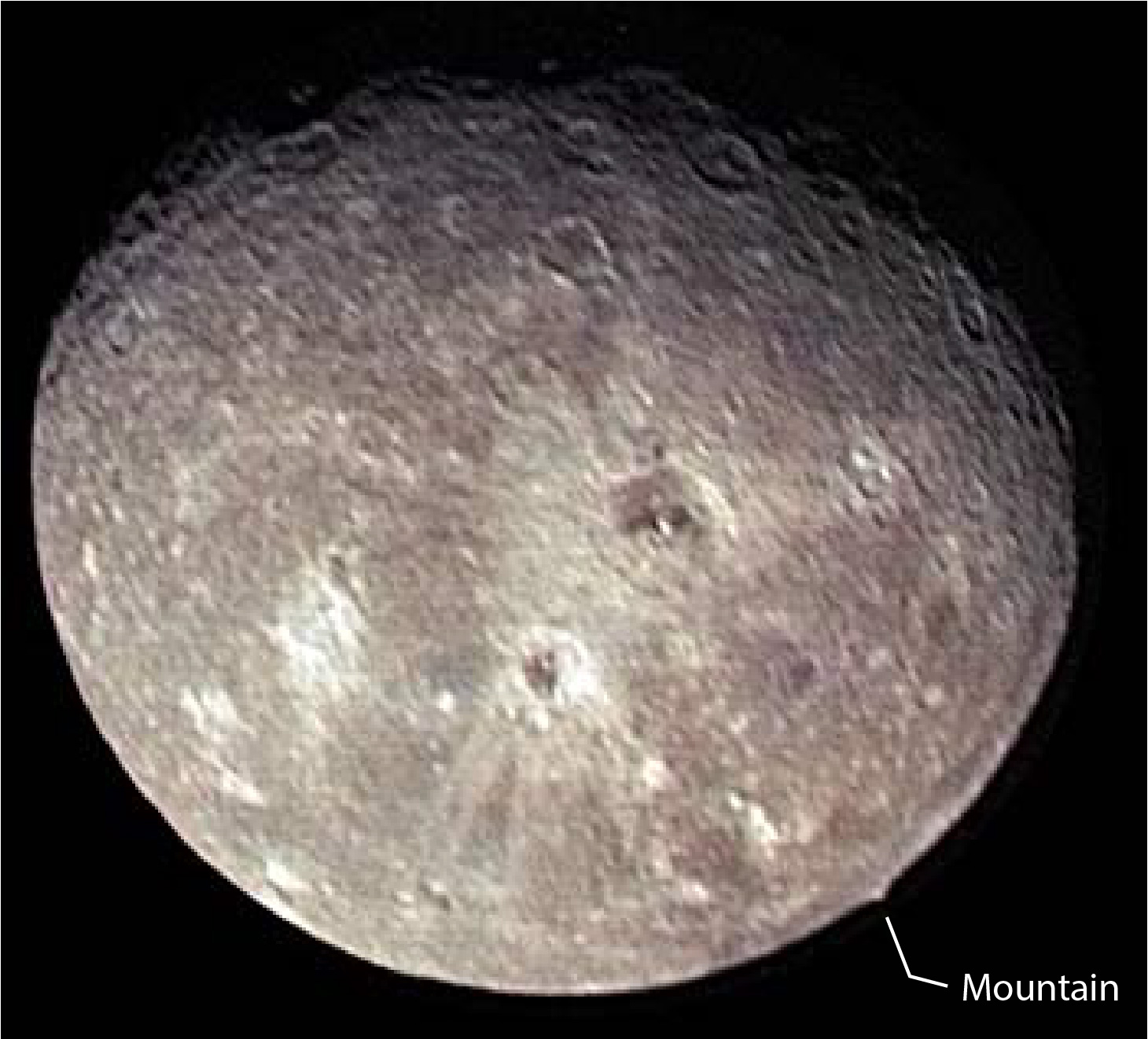
These facts show that although Oberon is one of the larger Uranian satellites, it has been largely inactive since the period of intense bombardment some 4 billion years ago. It thus fits the classic picture of a small satellite made of ice in the outer solar system, too small and too cold to generate enough heat to produce significant geologic activity after the differentiation of ice from rock. It has acted as a passive recorder of each encounter with projectiles orbiting the Sun as well as those in orbit around Uranus itself.
Uranus with its strange orbital and magnetic field properties, its host of rings and satellites, carries important clues about the nature and origin of the Solar System. The Voyager data have provided us with an overview of these features. Nonetheless, we are left with many unanswered questions regarding the evolution of the bodies in the Uranian system. For example, why is Uranus so much smaller than Jupiter and Saturn? At the distance Uranus lies from the Sun, the temperature must have been about 60 K during condensation from the ancient solar nebula. The core of ice and rock that accreted was probably smaller than the ones that formed at Saturn and Jupiter. Once the core was large enough, nebular gases became gravitationally anchored to the icy protoplanet. However, because Uranus is so far from the Sun that the amount of gas and dust in this part of the accretion was lower and thus the core was smaller and the trapped envelope of gas was also smaller. Or was it the dissipation of the gaseous nebula that halted the growth of Uranus?
Similarly, it is not clear that all of the moons of Uranus are internally differentiated into cores of hydrated silicate rocks and mantles of ice, like the moons of Jupiter. Some calculations suggest that during accretion the moons of Uranus may not have warmed sufficiently to allow the gravitational separation of ices and silicates. For small bodies like Miranda, accretionary heating probably was only a few degrees. Even if all the impact energy was converted to heat, the internal temperature of Miranda would have risen by only 30 K. Radiogenic heating might raise the temperature another 10 to 20 K. However, the probability of differentiation is increased if significant proportions of ammonia are mixed with the water ice. For example, pure water ice has a melting point almost 200 K above the present surface temperature (80 K), but if ammonia is mixed with the water ice, the mixture will melt at a much lower temperature, about 100 K above the temperature at the surface. This lowering of the ice melting point may increase the chance that even the small Uranian moons differentiated during their first few hundred million years of existence.
In the Uranian system we have discovered that two darker moons, Oberon and Umbriel---with relatively low densities (1.50 and 1.59 g/cm3), but quite different sizes (1520 and 1180 km in diameter)---have relatively primitive surfaces. These objects have surfaces dominated by many craters and appear to have experienced no late expansion---at least none after the heavy cratering of their surfaces. Two of their orbital companions, Titania and Ariel, with significantly different sizes (1580 and 1160 km in diameter) have similar but slightly higher densities (1.68 and 1.66 g/cm3) as well as surfaces disrupted by large extensional grabens. These global rift systems appear to have resulted from late expansion of the satellites and consequent stretching and rupturing of their icy lithospheres. The fractured satellites, Titania and Ariel, are also less densely cratered, and then only by smaller craters. Vast expanses of smooth plains are found on these bodies as well, suggesting that icy volcanic material was erupted from fissures associated with the expansion of the planetary bodies. We also outlined two contrasting theories for the evolution of Miranda, with its heavily cratered terrain and disrupted coronae; however, both ideas involved the partial differentiation of this tiny body after its final accretion.
Why are such dramatic differences developed on moons of such different sizes? Why aren't Titania and Oberon, moons with similar sizes, more alike? A radical explanation of the differences between Titania and Oberon harkens back to the reasoning used by some to explain the bizarre appearance of Miranda---that is, it relies on the complete disruption and reaccretion of some of the moons of Uranus. Some have speculated that Titania, but not Oberon, was shattered by collision with a large object late in the era of heavy bombardment. The debris from the collision reassembled into a new moon in a relatively short time, the new Titania also had an entirely new surface, which bore no trace of the early bombardment or previous extensional faulting. Oberon, at a greater distance from Uranus, would be less likely to be disrupted. Perhaps an early Ariel met the same cataclysmic fate as Titania. But how did Umbriel, which lies between Ariel and Titania, escape shattering as well? We expect that the number of collisions was greater on satellites closer to Uranus because of gravitational focusing of incoming objects. Even if we accept this theory, it does not explain why Oberon failed to develop extensional features.
Was tidal heating another contribution to the heat budget of any of the Uranian satellites and consequently to their thermal and tectonic histories? We have already seen that tidal heating was significant for the evolution of Jupiter's Io and Europa and also Saturn's Enceladus. The Uranian moons are not now in orbital resonance and thus cannot be receiving a thermal input from tidal flexing. However, it is possible that Miranda, Ariel, and Umbriel have passed through a resonance in the past. In fact, the noncircularity of their present orbits may have been produced when former resonant configurations were destroyed. Ariel might have been significantly heated if it resided in resonance with Umbriel for a long time. However, heating of Umbriel would have been negligible, because of its greater distance from Uranus and smaller tidal distortions. This idea is consistent with the heavily cratered surface of Umbriel. The temporary trapping of Miranda in an orbital position where tidal flexing or chaotic rotation was important might have caused a thermal event that resulted in its partial resurfacing and development of the coronae. Unfortunately, this list of possible resonances and potentials for tidal heating does not include tectonically modified Titania.
Perhaps part of the explanation for the differences among the satellites lies in the compositions of the satellites as reflected in their densities. Both Titania and Ariel, which appear to have longer tectonic histories with late lithospheric extension, also have higher densities, perhaps implying that they have more of a dense silicate component and less ice in their interiors than the less-dense Oberon and Umbriel. Incorporated in the silicate materials are small but significant quantities of heat-producing radioactive elements. Therefore, it is conceivable that Titania and Ariel with their larger silicate fractions contained just enough radioactive elements to augment their differentiation and tectonic processes started by accretion. Thus, cooling and consequent fracturing of this pair might have occurred later during the period of reduced cratering rates. Oberon and Umbriel, the darker, less rocky, bodies less well endowed with radioactive elements, may have cooled more quickly and perhaps expanded during the intense bombardment associated with the end stages of accretion. Little evidence of ancient geologic events such as volcanism and faulting has survived the early resurfacing of Oberon and Umbriel by impact processes.
1. Among the planets of the solar system Uranus has unique orbital properties. What are they and what is a possible explanation for them? What suggests that the orbit was changed before the satellites formed?
2. What might account for the compositional differences between Uranus and Saturn?
3. Why is the atmosphere ice ratio of Uranus smaller than that of Saturn?
4. Which is more important for the movement of gases in the atmosphere of Uranus, the rotation of the planet or the input of solar energy? Would the answer be the same for Earth?
5. In what way do the ring particles of Saturn and Uranus differ?
6. Prepare a table that compares the diameters, densities, surface compositions, ages, and features of the five major satellites of Uranus.
7. How do the densities of the satellites of Uranus and Saturn compare? Is that predicted by simple cooling of the solar nebula? How might the difference in density be explained?
8. Contrast the resurfacing histories of Oberon-Umbriel and Titania-Ariel. What geological differences can account for their different histories?
9. How does Miranda differ from its icy neighbors?
10. Do any common themes about the evolution of small, icy bodies emerge from a comparison of the satellites of Jupiter, Saturn, and Uranus?